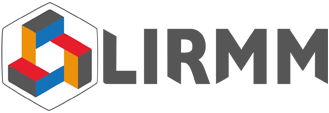The LIRMM’s Robotics Platform is a technological platform dedicated to research, technology transfer and teaching. It is part of the national ROBOTEX network (French Research Investment “Equipements d’Excellence” projects) of experimental robotics platforms.
The Robotics Platform houses hardware and software equipment and resources, and brings together the engineers who design and maintain our robots. Four experiment halls with a total surface area of more than 1,000 square meters are home to LIRMM’s humanoid robots, parallel robots, underwater robots, land mobile robots, collaborative robots and surgical robots.




Robotics for the industry of the future

- physical human-robot interaction
- fast and precise manipulation in large spaces.
- 1 humanoid robot HRP4.
- 1 humanoid robot HOAP
- 1 cobot (BAZAR) collaborative robot for industry and health which allows co-manipulation between man and robot.
- 1 Kuka robotic arm
- 1 robotic arm SIA20 Yaskawa: 7 axes. Load 20Kg. Vertical reach 1498 mm. Horizontal reach 910 mm. DX100 controller.
- 1 parallel robot Quattro Videos.
- 1 large cable parallel robot COGIRO
- 1 mobile robot PIONEER.
- 2 hands Shadow
- 2 Laser scanners SICK: Measuring range: 49m.
- 1 laser tracker
- We also have a professional 3D printer (STRATASYS FORTUS 400) which allows the manufacture of large volume mechanical parts (400x400x400mm).
Surgical robotics



-
Regional-level objectives include:
- Developing medical robotics activities in the French Occitanie Region by designing and building cutting-edge technology systems for robot-assisted surgery.
- Shoring up partnerships between our LIRMM Surgical Robotics research team and hospital practitioners and professionals.
- Fostering collaborations with economic players to translate research activities into industrial applications.
- Highlighting the activites of this platform.
- Granting LIRMM regional medical partners (CHU Montpellier, CHU Nîmes, …) and extra-regional partners (Hôpital La Pitié Paris, CHU Grenoble, …) access to a modular and evolving technical platform for training on cutting-edge technology and specifying new needs, thereby aiding in the improvement of existing systems for the benefit of patients and users.
- Granting access to a CNRS-sponsored, LIRMM-managed technology platform.
|
 |
|
 |
|
 |
|
 |
|
 |
|
 |
|
 |
|
 |
|
 |
|
 |
|
|
|
 |
|
 |
|
 |
|
 |
|
 |
|
 |
|
 |
Underwater Robotics

Developing underwater robots for marine applications (archaeology, biology, industry) and karst exploration.
Keywords: Remotely Operated Vehicles, Autonomous Underwater Vehicles, Sensors, Controllers
- Several unmanned underwater vehicles:
- LEONARD ROV, an ROV for underwater archaeologye, also used daily as a test platform for advanced controllers,
- BENDER ROV, a new for underwater archaeology, marine biology and industrial applications,
- ARTHUR ROV for deep-sea archaeology (up to 2500m),
- ULYSSE for karst exploration (Gourneyras abyss) and for fish counting missions,
- 1 DVL (Doppler Velocity Log – A50 Waterlinked, 1MHz) to acoustically measure the speed of an underwater robot with respect to the seabed.
Pictures of underwater robots : DRASMM/Images Explorations – F. Osada / T. Seguin and Frank Vasseur
Software has been developed, some of which has been the subject of an APP deposit:
- ANGIOSPAN (EXPLORE), 2017 (IDDN.EN.001.150022.000.S.C.2017.000.31230). AngioSpan software allows for on-record analysis of vascular ultrasound image sequences.
- OpenPhri (IDH) is a C++/Python software designed to facilitate robot programming for physical human-robot interaction (pHRI), 2019.
- MC-RTC (IDH) is an interface for simulated and real robotic systems suitable for real-time control, 2019.
Frameworks are also being developed to facilitate software developments:
- PID: PID defines a development methodology based on the CMake APIs: it provides many general third-party or native projects for developers and specific projects such as pid-rpath and pid-log that implement the PID execution mechanisms.
- RPC: Robot Packages Collection (RPC) is the common place where you can find many useful packages for developing robotics applications, ranging from drivers for robots and sensors, to commonly used algorithms, simulators, etc.
- ETHERCATCPP: Ethercatcpp allows defining and reusing drivers for robots and devices based on ethercat technology.
- HARDIO: hardio allows you to define and reuse drivers for embedded systems such as the Raspberry Pi, Beagleboard, etc. This is particularly useful for mobile robotics applications.
- RKCL. The RKCL provides a set of tools for implementing multi-tasking and whole-body kinematic control for robots as well as extensions to manage the interface with hardware or simulators (robot and sensors).






